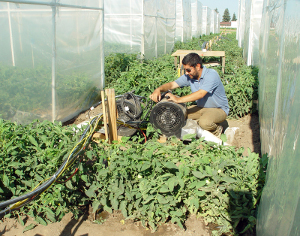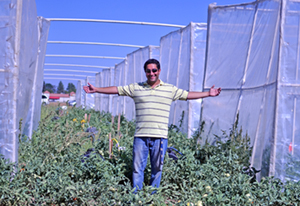California Agricultural Technology Institute
Tomatoes get CO2 enrichment during growth trials
Application around crop canopy expected to enhance plant photosynthesis, productivity, and water use efficiency
 A unique plant science experiment being conducted by a Fresno State graduate student
has attracted the attention of researchers from both universities and government agencies
interested in the prospect of reduced greenhouse gas emissions.
A unique plant science experiment being conducted by a Fresno State graduate student
has attracted the attention of researchers from both universities and government agencies
interested in the prospect of reduced greenhouse gas emissions.
Bardia Dehghanmanshadi, an international student from Iran, is completing his master’s thesis with a study of how treatments of carbon dioxide gas on fresh market tomatoes affect plant growth rate and yield. The work is being conducted under the guidance of assistant professors Florence Cassel Sharma and Dave Goorahoo, who also conduct research for the Center for Irrigation Technology (CIT).
The research team used special greenhouses to treat tomato plants with extra doses of CO2 gas, which was pumped into the chambers through a custom-designed airflow system. The chambers have no cover – for a reason.
“We wanted to make conditions for this experiment as close to real field conditions as possible, so we left the covers off to allow the CO2 to dissipate naturally,” Bardia explained. The chambers did allow certain controls such as preventing wind from dissipating the gas too quickly, he said.
 The purpose of the experiment is to evaluate how tomatoes respond to the elevated
CO2 levels. Plants require CO2 (gas) for their metabolism in the same way humans require oxygen, Cassal Sharma said.
So the hypothesis is – would plants grow and produce better if they get extra doses
of the gas they love?
The purpose of the experiment is to evaluate how tomatoes respond to the elevated
CO2 levels. Plants require CO2 (gas) for their metabolism in the same way humans require oxygen, Cassal Sharma said.
So the hypothesis is – would plants grow and produce better if they get extra doses
of the gas they love?
“We’re looking for simple and efficient techniques for recycling CO2 emissions in agricultural fields to enhance crop productivity and water use efficiency,” Cassel Sharma said.
Primary producers of CO2 in California include gasoline- and diesel-powered vehicles and equipment, power and cement plants, and oil refineries. CO2 is noted as one of the most prevalent of all the greenhouse gases produced by humans.
“A novel use of these emissions could be found in the agricultural sector since CO2 is the primary component of photosynthesis and therefore plant growth,” Cassel Sharma said. “Application of CO2 around the crop canopy could enhance photosynthesis and thus increase crop productivity and water use efficiency.”
Previous CIT studies indicate that CO2 enrichment of open field crops has a good chance of success, reported Goorahoo, who along with Cassel Sharma has conducted small-scale CO2 enrichment trials on other crops in recent years. Increased yields were observed on bell peppers and strawberries, he noted.
The current study was conducted over two summer growing seasons, with the second one just completed. CIT research associate Shawn Ashkan designed and supervised the construction of the greenhouse chambers and CO2 delivery system. In addition to the extra doses of CO2 gas, some of the plants received irrigation water at deficit levels.
 As part of the experiment, plants were sampled regularly during the growing season
and measured for leaf area, nutrient content and weight. Photosynthesis measurements
were taken for each CO2 and irrigation treatment. At the conclusion of the growing season in September, tomatoes
from the different treatment groups were harvested. Yields will be measured along
with plant and root biomass. Results will be disseminated through various outlets
including conferences and industry events.
As part of the experiment, plants were sampled regularly during the growing season
and measured for leaf area, nutrient content and weight. Photosynthesis measurements
were taken for each CO2 and irrigation treatment. At the conclusion of the growing season in September, tomatoes
from the different treatment groups were harvested. Yields will be measured along
with plant and root biomass. Results will be disseminated through various outlets
including conferences and industry events.
"The farm industry has a lot to gain if an economically efficient method for delivering CO2 can be developed," Cassel Sharma said.
Funding for this research was provided by the California State University Agricultural Research Institute (ARI). For more information, contact Cassel Sharma at fcasselss@csufresno.edu.